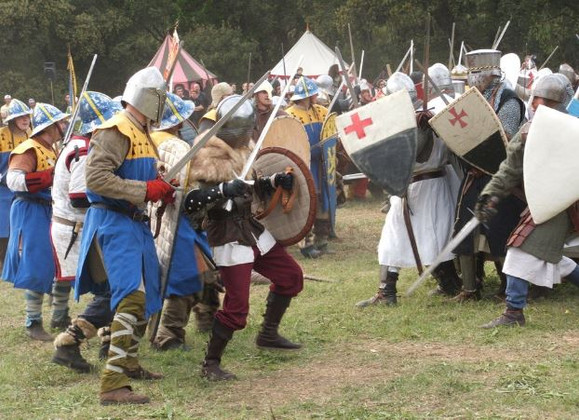Behind The Scenes Look For What Goes Into Doing a Medieval Reenactment
Posted by Sword N Armory on Jul 8th 2019
The short answer is ORGANIZATION.
The Beginning
Start with an evaluation of your resources.
This begins with estimating the number of participants you can expect. Based on that estimate and the people available to participate in managing the reenactment, select the participatory activities for the event. These can include competitions of period cooking, crafting demonstrations and sales, musical performances including period dance and, of course, a battle.
If you include any activities involving horses, you're entering a demanding level of management and potential injury, which you should consider soberly before releasing the details of the event.
Venue
Once you've a good idea, not necessarily a perfect idea, but a good idea of the activities the will comprise your day, you need an appropriate venue with satisfactory locations for all of the activities. By this point, you have people in charge of the different aspects of the reenactment who can estimate how much room they need.
If you're having a battle, it is best placed at the central point of the venue as it consumes the most room, requires many participants and may be decorated to build excitement. The battle participants themselves form no small part of the interest in the reenactment, so placing them so everyone can see them making ready for battle is a great way of maintaining interest until the scheduled start time.
To War
Everyone interested in the medieval time period loves the idea of reenacting a famous battle. However, before scheduling a battle rather than, for example, demonstrations featuring the use of different period weapons, you require experts who understand the details of the battle you're imitating and sufficient leaders to manage the participants.
Battles are great medieval reenactment centerpieces and there are many ways of ensuring they are effective, safe and fun. With the emergence of small, reasonably-priced microphones, you can begin battles with challenges, delivered with period language and seriousness, accompanied by brilliantly dressed support personnel. The leaders of the forces can exchange several such verbal salvos before the battle begins. This serves to provide background, entertain, provide roles for as many participants as possible, and is a “soft start” to the combat so the late-comers can arrange themselves.
Managing Weaponry
Even replicas of medieval of instruments of war can cause injuries. Best practices in this case include relying on the good sense of the actors, publishing specific parameters for the display, storage and use of the weapons and reiterating to all participants that real injury is not fun for anyone and is to be avoided.
Scheduling
Since the battle is generally the biggest draw of the medieval event, schedule it later in the day, perhaps in the early afternoon. This leaves ample time for the musicians, dancers, fools etc. to perform. Placing the crafts and other demonstrations around the perimeter of the performance area enables your guests to multi-task, enjoying music and comedy while shopping or learning to weave. Ideally, schedule performances and demonstrations both before and after the battle so even the combatants can enjoy the day’s offerings.
First Aid
There's no medieval reenactment without a first aid area. You can use an anachronistic EMT truck or have volunteers at a tent, but some kind of First Aid station is essential, if only armed with ice packs and water. Period costume is nothing if not hot and the battles are rife with incidental injuries. If nothing else, the First Aid area provides a place for the injured to wait until professional help arrives.
Since it's entirely likely that there will be at least one accident, we suggest notifying the local emergency first responders of your event. This may be no more than sending them an informational flyer. This enables them to become familiar with your plans and the location of the event just in case – no one really likes surprises.
Managing Participants
Once you establish your schedule for the reenactment, each of your lieutenants must manage an area of the event. As people register, forward the registrations to the appropriate music, dance, and military manager. If you're having a battle, the military manager will need more help if the registration is substantial.
Managing the Battle
Generally, you choose to re-enact an historic battle or plan one of your own invention. Much depends on the number of people who register to fight and their characters. With sufficient participation, we prefer the historic reenactment for several reasons. For one thing, it provides a template for the activity. For another, there is less arguing because you can’t vary from history and lastly, you know where everyone has to be when.
If you choose to create a battle, keep in mind that people are attending to participate, not to sit around being lectured or bullied into lines.
With organization and dedicated help, you can have an enjoyable day for all participants without serious injury, festooned with the finery of medieval times, which's what most people want after all.










